Hello again to all my fellow cube lovers. I’m back! I’m sorry it took me this long—well over a month—to get y’all some new cube content, but it’s been hard to write about Magic as of late. One positive outcome of this time lapse is I’ve had some time to test all the Ikoria cards I had wanted to; I’m happy to report I have good reps and feedback under my belt.
I won’t be doing a color-by-color analytical ranking system this time, but instead a roundup of the bigger picture of Ikora’s impact on Cube. I’ll go through each of the supported mechanics and highlight the cards I feel particularly strong about, and come to some sort of conclusion over why these things work, and why some other’s don’t.
Then, I’ll finish things off with a look at some of the more individually powerful cards in the set, and how they’ve managed to played out. And I’ll rank my top cube picks from Ikoria. No letter grades here, just analysis and conclusions. So stick around!
Let’s start things off by talking about everyone’s most beloved mechanic, Companion!
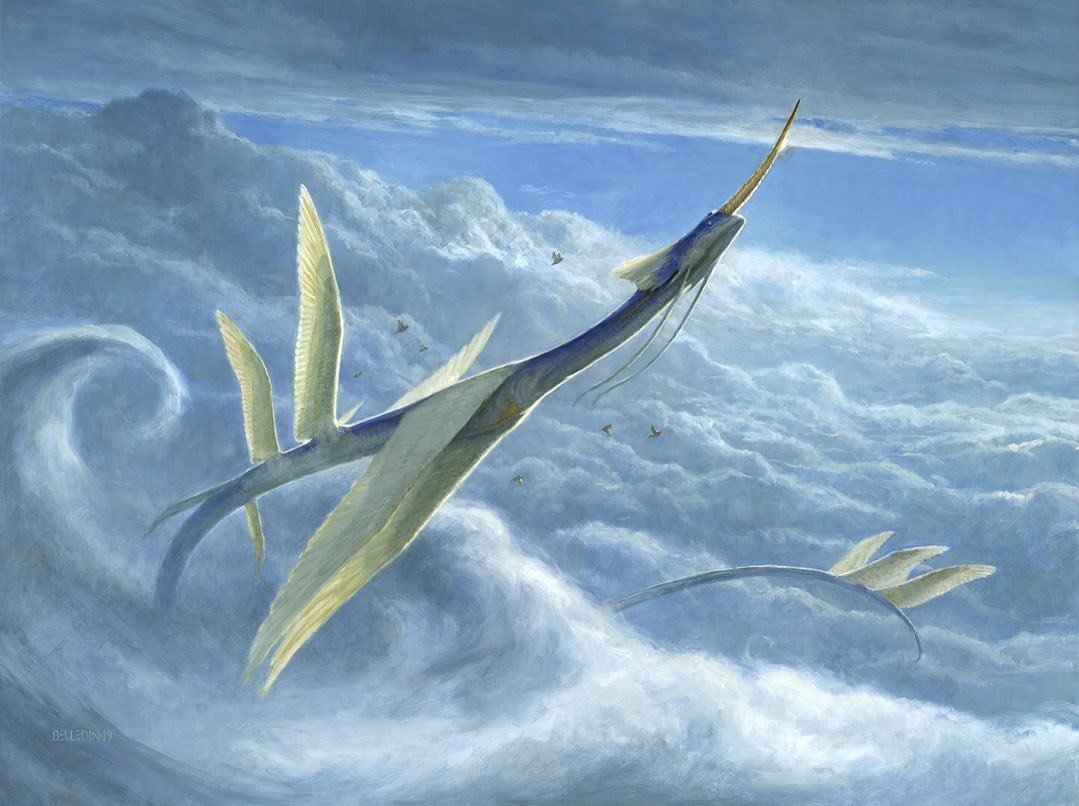
Companion
As some of you might remember I wrote an article recently on whether “Cube”—and by using these quotations I mean not just my cube, but the entirety of cubes and cube designers that comprise our community—was ready for Companions. This was written before the change (or “nerf”) to the mechanic, so I thought it’d be worth readdressing the Companions as they now stand.
While the mechanic has been significantly neutered, my opinion on their role in Cube hasn’t really changed much at all. Some of us (read: me) believed they’d simply be banned from existence, from all formats across Magic. Well, we now have The Companion Tax! And what a tax it is!
Everyone who starts with a companion now starts with this makeshift Demonic Tutor of sorts, where you “cast it” for only one target, and only once per game. It’s not the cleanest fix, but it certainly did what it set out to do: take the Companions down from Totally Unbelievable to Acceptably Broken. As in, “It’s broken, but at a level I’m willing to accept.”
So for Cube the question becomes, “Is three mana enough of a tax such that I’ll now give em a shot in my environment?” From what I’ve seen and heard, the answer is reasonably divided; but still I think more of us are willing to test with or play them now than they were before. This is good—or at least I think it is? However, I still think the mechanic is too strange and too similar to Conspiracy, even in light of how novel a ride the draft experience becomes when, say, starting it with a Companion.
If you’ve landed on the side of running them, the ones I’ve played with or seen perform well are Yorion, Lutri, Lurrus, and Gyruda. Yorion is the most bizarre/fun to try to make work—I had a nearly Mono-White Yorion deck during the Magic Online Legacy Cube that was a delightful abomination—with Lurrus and Gyruda doing the heavy lifting when it comes to clever deckbuilding constraints and goofy gameplay. Lutri, however, is still kind of a joke. It’s totally free in Cube, without encouraging anything unusual or inducing any cleverness in “achieving” what the Companion asks of you. See a Lutri? Just put it in your deck and move on! Where’s the fun in that?
Beginning the game with an eighth card is utterly ridiculous. I believe you should reserve Companions to formats where you’d expect to see Conspiracies: at the highest peak of the tallest mountain. While they might have radical and even occasionally positive implications on the draft experience, the gameplay patterns still feel kinda same-y, lacking meaningful replayability, and are overall miserable to play against.
Cycling
On the other hand, Cycling is an old mechanic and much beloved by most Magic players. Ikoria supports cycling in no small way, adding a wealth of new, sometimes aggressively-costed cyclers to the card pool. Before Ikoria we’ve seen Cycling 2, Cycling X (one mana of the specified color), or some other, often times exorbitantly costed cycler that’ll pay you with a spell-like effect. The majority of cycling cards in Ikoria have Cycling 1.
It’s hard to overstate how unbelievable Cycling 1 actually is, but it’s also very important to note that the other half of the card, the spell half, must still hit a power threshold to warrant inclusion. Being modal is great, and for some cube designers is one of the more important aspects of card evaluation. I agree with this, but it’s in no way an exact science.
Anyone who played Ikoria Limited knew that cheap cyclers were present in abundance and rarely, if ever, did much besides get you closer to Zenith Flare. Casting Boon of the Wish-Giver didn’t come up that much—but in Cube we’re more likely to cast Boon, as the other half is Tidings. I tested both Frostveil Ambush and Boon of the Wish-Giver; and while I actively wanted to cast Boon, I didn’t want to cast Ambush. This is why Censor and Hieroglyphic Illumination are great cube cards.
Other cycling cards which pulled their weight were Neutralize and Wilt, as you’re happy to include them in most any deck that can cast them. It turns out if you add Cycling 2 to Cancel or Naturalize, you have what could very well be a Cube staple.
But this write-up wouldn’t be complete without mentioning the biggest, baddest cycler of them all. Shark Typhoon needs no introduction; it’s an absolute house. I knew this card would be great, and after testing I can safely say it’s even better than I imagined. Consider it has four different modes: Cycles for 2 when you really need to, Cycles for 3 or 4 to make a quick trade or a chump blocker, Cycles for 5 or 6 to make a win condition, or the oft-overlooked Hard It Cast Because I Can mode, which is a lot of fun.
That it’s all these things at once—Modal!—is why it’s so powerful. Shark Typhoon is never a bad draw and basically any Blue deck will want it. If anyone reading this hasn’t bothered to put it in your cube, do yourself a favor.
Mutate
Do yourself a favor and observe caution when treading into mutate territory. I really liked the idea behind this mechanic and was excited by a few cards in the set, but the more I played with mutate creatures the less I liked them. My main issue is the cost of mutate is too high, as you’ll be “sacrificing” one of your creatures to plop a mutate creature onto it.
The payoff for committing to mutate better be worth at least a card for me to be interested, and on top of that the body better be good. After some testing, the two that get there are Gemrazer and Everquill Phoenix.
Gemrazer has been fine as a statmonster for my midrange Green decks, and getting a Naturalize stapled onto it feels like the best Reclamation Sage I’ve ever cast. If they respond by killing your mutate target, you still get a three-mana 4/4 with Reach and Trample, which is a damn good rate. I’m not a fan of Reclamation Sage as my three-mana slots are filled with beef over utility creatures, so Gemrazer has a good home in my cube.
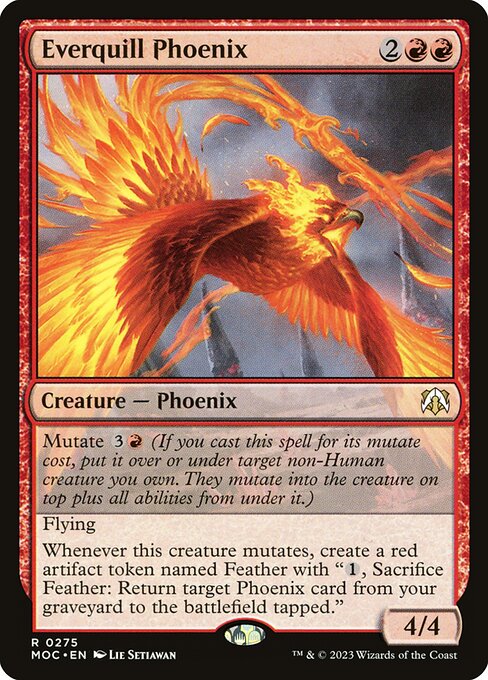
Everquill Phoenix surprised me once I started playing with it. I’ve played them as a top end threat in Red aggro or a Green-based midrange deck. Trading in a creature for a 4/4 flier that has haste and leaves you a way to rebuy itself is worth the investment. You really want to mutate this creature, however, as casting it outright can feel disappointing for what we’ve come to expect from our Red four drops. If you like playing with the Red Rabblemasters or otherwise heavily support Red aggro, you’ll be happy Mutating onto a random token or redundant creature.
Aside from these two, however, I haven’t tested the mutate creatures as much. The mythic Apexes look too clunky, and many of the other payoffs are either overcosted or don’t effectively replace themselves.
Triomes
I think these new tri-lands are okay for cube, but not a slam dunk as some of us initially envisioned them. Coming into play tapped has a very real cost, and Cycling 3 is a mana too expensive to be efficient. If your cube is slow, however, and you heavily support multicolor midrange and control battles I like them a little more.
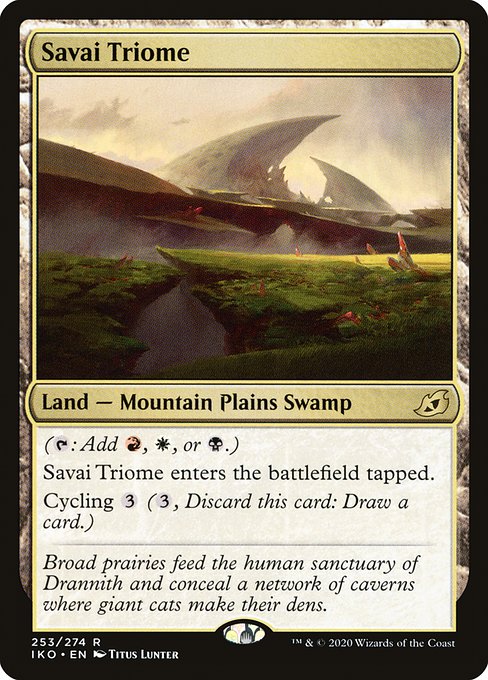
If you’re a madman and play double fetchlands in your list, these also go up in value. Being fetchable is a big deal, but I was left feeling underwhelmed by them when the gap between a Triome and any ETB Untapped land was wider than expected.
Other Good Stuff
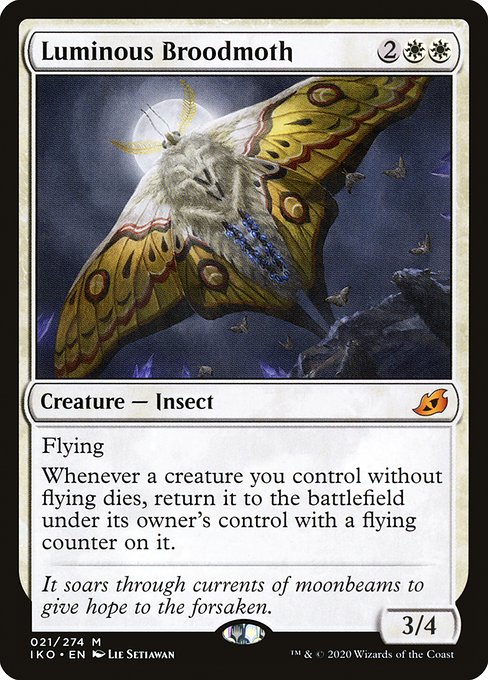
Luminous Broodmoth has been hyped as another piece of the “persist combo” puzzle. I’m not excited by this as this archetype doesn’t come together all that often, even when well supported. It’s a fine card for White aggro, as curving out into Broodmoth is nice as well as giving your other non-flying creatures protection from Wrath effects. However, it’s just a Baneslayer with some ocassional upside. On raw power level I’d rather play Restoration Angel every time, but I respect the possibilities inherent in the card.
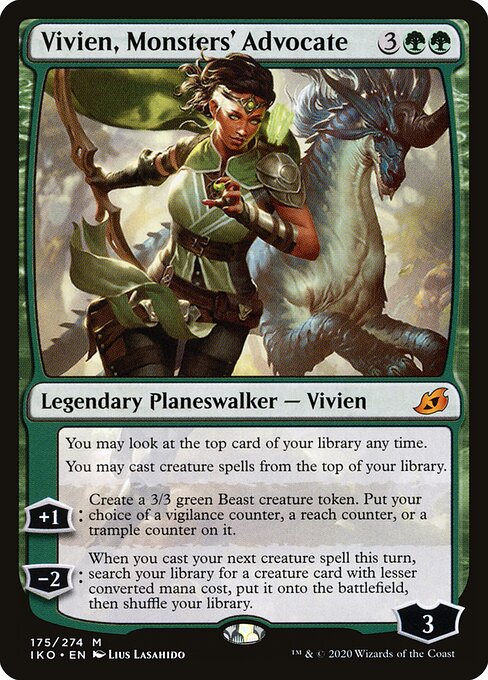
I’m always in the market for another Green planeswalker, and Vivien Monsters’ Advocate is very welcome. She packs such a punch for only five mana that I wonder why we bother to play five mana creatures at all anymore! In addition to being a Beast factory, she lets us sometimes spike a creature off the top of our library and allows us to tutor up creatures right onto the battlefield. Yeah, okay, she doesn’t have an ultimate, but she doesn’t need one. Compare this card to Biogenic Ooze or Whisperwood Elemental. We trade off getting two creatures for a Planeswalker plus a creature, and get a massive upgrade in agency.
I’ve had her in play several times already, and while she doesn’t directly end the game, she largely contributes to it. Vivien is a slam dunk that I’m excited to continue playing in my cube.
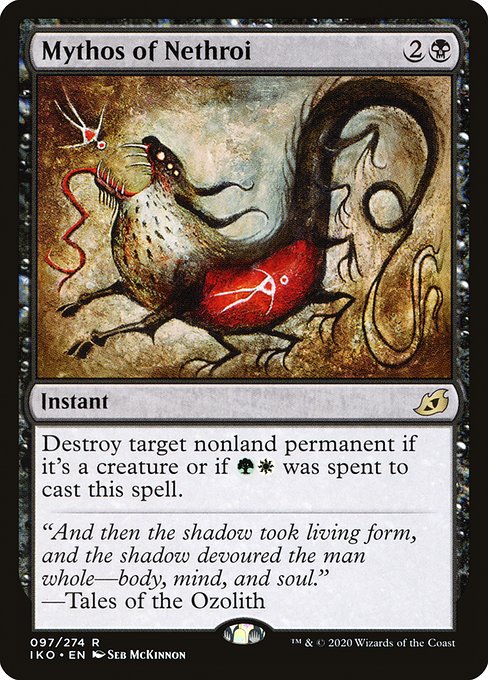
Three mana Black removal is clunky, which is why we tend to play the ones that kill things other than creatures. Mythos of Nethroi is an easier-to-cast Murder with an awkward kicker cost. It’s not impossible to kick, but it’s not easy either, even with a good mana base. If your cube runs 540 cards or more, this is a fine bit of redundancy, but don’t expect this to consistently be Hero’s Downfall.
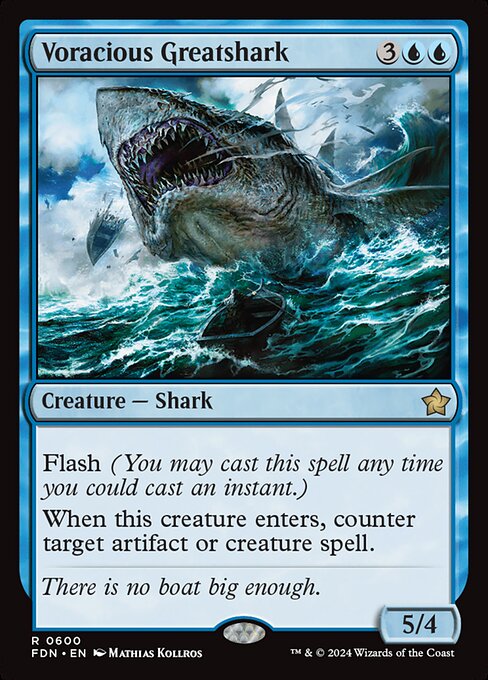
Evaluating Voracious Greatshark went rather contentiously. Yes, it does multiple things; but it executes each thing less well than a slew of other blue cards, and at lower mana costs too. Five mana is a lot to invest into a threat that doesn’t carve its own path to winning the game. Still, in testing the pieces kept coming together when Sharky was cast, and I grew more impressed: the damn card just kept working. Never overperforming—but really, did I expect it to? No, but I also didn’t expect to be casting it as a flash 5/4 as much as I did.
Greatshark is hard to hold up over multiple turns, as it starts to become glaringly obvious what you’re trying to do. It’s part additive distraction, part greedmonster to stick to the dream of getting that ETB trigger. Sometimes you just gotta jam, and Sharky here encourages us.
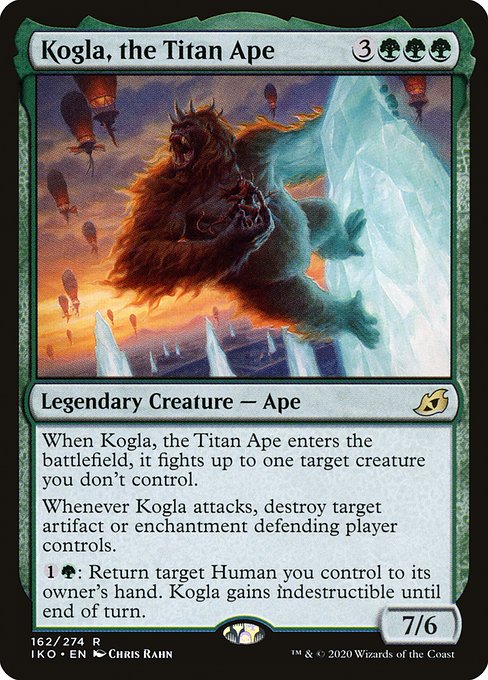
Getting King Kong as a Magic card was definitely cool, and funny. Kogla works well, then, as a top-down design. He beats someone up, gets angry and tears something down, a nod to the human/non-human bond tucked into the bottom of the text box. Kogla’s ETB is really where the money is, so he shines in midrange matchups. That he doesn’t have trample is kind of a bummer, as he can be chump blocked ad nauseam, and that never feels quite right.
Outside of these midrange mirrors, he’s just crap. Too clunky and expensive against aggro, too Baneslayery for control. The “built-in evasion” isn’t much beyond flavor text, and the attack trigger doesn’t come up often enough to matter. Sure, some of you will tell me about the game where you reset your Charming Prince or whatever and got infinite value. If that’s the kind of game you’re trying to play then lemme break it to ya: you’re long on more efficient methods of inflicting your choke hold. Kogla ain’t it.
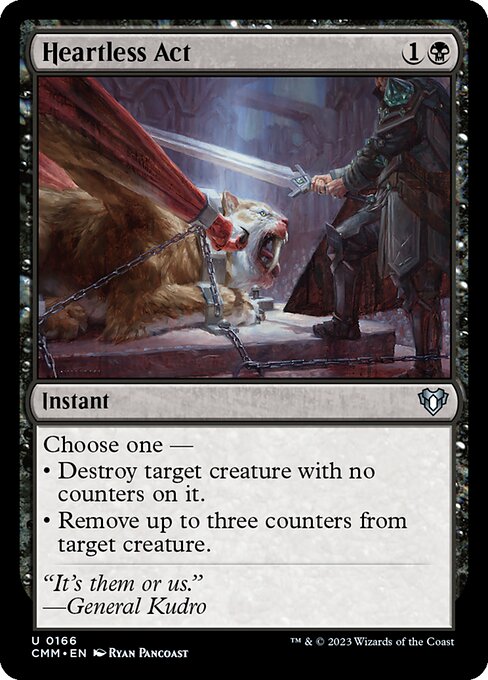
Every Black two-mana removal spell has some small drawback that comes around to bite you in the ass. Maybe one day we’ll get MurderBlade, and that really might not be far off the way power creep has been going. Until then, take your efficient removal spell, be happy, and move on with your life.

Red removal that doesn’t SMorc—that’s Go Face, for those who don’t know—loses measurable value for a Red mage. The utility has to be palpable, which is why playing Abrade in a format with Signets makes sense. Fire Prophecy basically draws you a card on top of being spot removal, which is something considering Jaya’s Greeting was just printed a year ago.
When Red offers card selection like this, especially tacked onto a removal spell, it’s hard to not at least consider running it. For now, the trade off for me is still too high, as I need all my burn to Go Face. But I wouldn’t blame anyone for playing with this card.
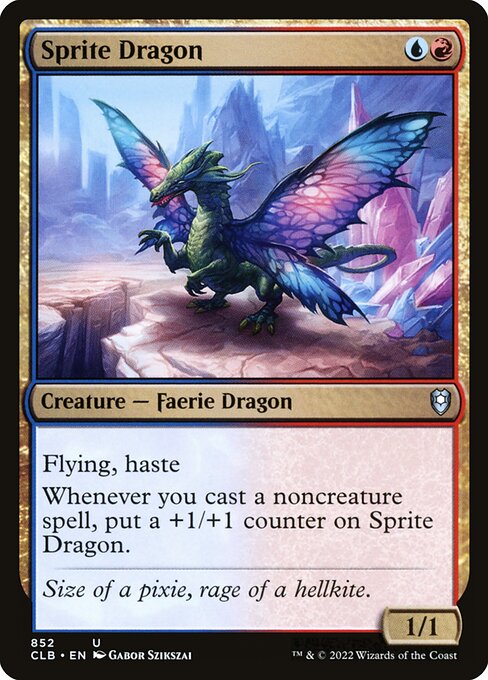
Izzet “Tempo” decks are popular with many Cube designers, and I know a number of us who really wanted Stormchaser Mage to be a thing. Sprite Dragon is so much more exciting a card. It’s not an archetype definer, but a solid role player for anyone who robustly supports these aggressive Delver style decks.

Everybody loves a good sweeper, right? Extinction Event is not a great card, and there are plenty of times you’ll draw this and realize why. I think I’d rather play any Infest variant before running Extinction Event, but if you’re hard up for sweepers in your list this is a fine bit of redundancy.
Ikoria Power Rankings
1. The Companions
2. Shark Typhoon
3. Boon of the Wish-Giver
4. Vivien, Monsters’ Advocate
5. Heartless Act
6. Neutralize
7. Gemrazer
8. Voracious Greatshark
9. Everquill Phoenix
10. The Triomes
Ikoria wasn’t a slam dunk of a set, but the high mark of its contribution to cube—in particular Shark Typhoon—is excellent. I’m not saying they should print sets like this over and over again; they shouldn’t. But this power level push has proven continuously to be a golden age of cube evolution, and in calling it that I’m excited to see where all these busted cards will take us. In a year, two years.
What will cube look like then? How will we be addressing and readdressing what is known and what is sacred or fundamental? It’s an exciting time to be a Magic player, and an even more exciting time to be a Cube designer. Next time we’ll look back over the last year at the new cards introduced into Cube and have stayed, what the lasting impact has been, and what cards I was totally wrong about.

